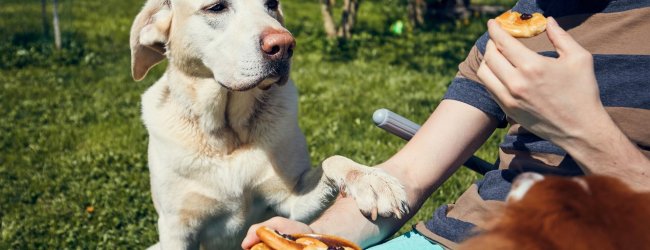How To (Safely) Go Geocaching With A Dog
Geocaching with a dog is the perfect way to make walks more exciting and rewarding. Here's how to do it safely & where a GPS tracker helps.
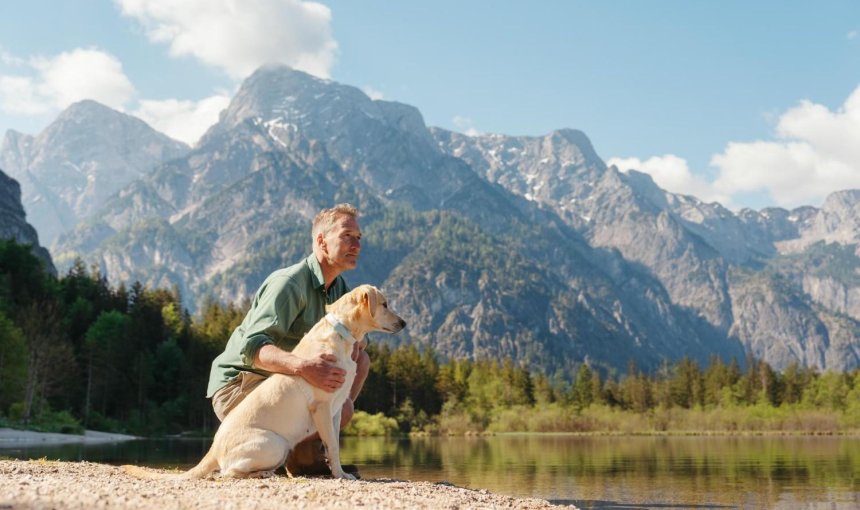
If you’re looking to add a new twist to your daily walks, geocaching with a dog is a fun, active, and mentally stimulating way to explore the outdoors together. In this guide, we’ll cover how to get started, safety tips, dog-friendly gear, and how the Tractive GPS & Health Tracker for dogs can be your peace-of-mind backup on the trail.
Key takeaways
🪙 Geocaching is an outdoor treasure hunt using GPS coordinates to find hidden containers. It’s a great way to make daily dog walks more exciting and mentally enriching.
🛟 Always prioritize safety – bring water, check for ticks, and monitor your pup’s energy levels.
🧤 Gear up with dog-friendly essentials like a comfy harness, treats, poop bags, and gloves.
🌎 The Tractive GPS & Health Tracker for dogs helps you keep your pup safe if they wander or get off-leash during your adventures.

Always know your buddy is healthy & safe
Read moreWhat is geocaching (and why your dog will love it)
Geocaching is a global outdoor activity where people use GPS devices (or a smartphone) to find hidden containers called “geocaches.” These are tucked away in parks, forests, cities, and even rural backroads. Inside a geocache, you might find small trinkets, a logbook to sign, and sometimes travel bugs that journey from one geocache to another.
All you need is a GPS-enabled phone, a geocaching app, and a sense of adventure – and yes, your dog can absolutely come along for the ride! Geocaching adds a playful, problem-solving element to your walks – turning them into mini adventures. Your dog will love the new sights and smells, plus the physical and mental stimulation will keep them healthy. Making for longer, more interesting walks and also some quality bonding time for you both.
But before you grab your GPS and leash, take a minute to consider:
Is your dog a good fit for geocaching?
- Age
Puppies and senior dogs might not have the stamina or joint health for extended outdoor adventures. Stick to shorter, easier routes if your dog is very young or elderly. - Breed traits
Energetic, outdoorsy breeds like retrievers, collies, or terriers often thrive with geocaching. Brachycephalic (flat-faced) breeds like pugs or bulldogs may overheat more quickly or have breathing difficulties during exertion. - Health status
If your dog has any medical conditions – like joint issues, heart concerns, or allergies – check in with your vet before planning a geocaching adventure. - Prey drive
Some dogs love to chase wildlife. If your pup is easily distracted by squirrels, birds, or scents, a secure harness and leash are a must. - Spay/neuter status
Intact dogs may be more likely to roam or become reactive around other animals. Be especially cautious on shared trails.
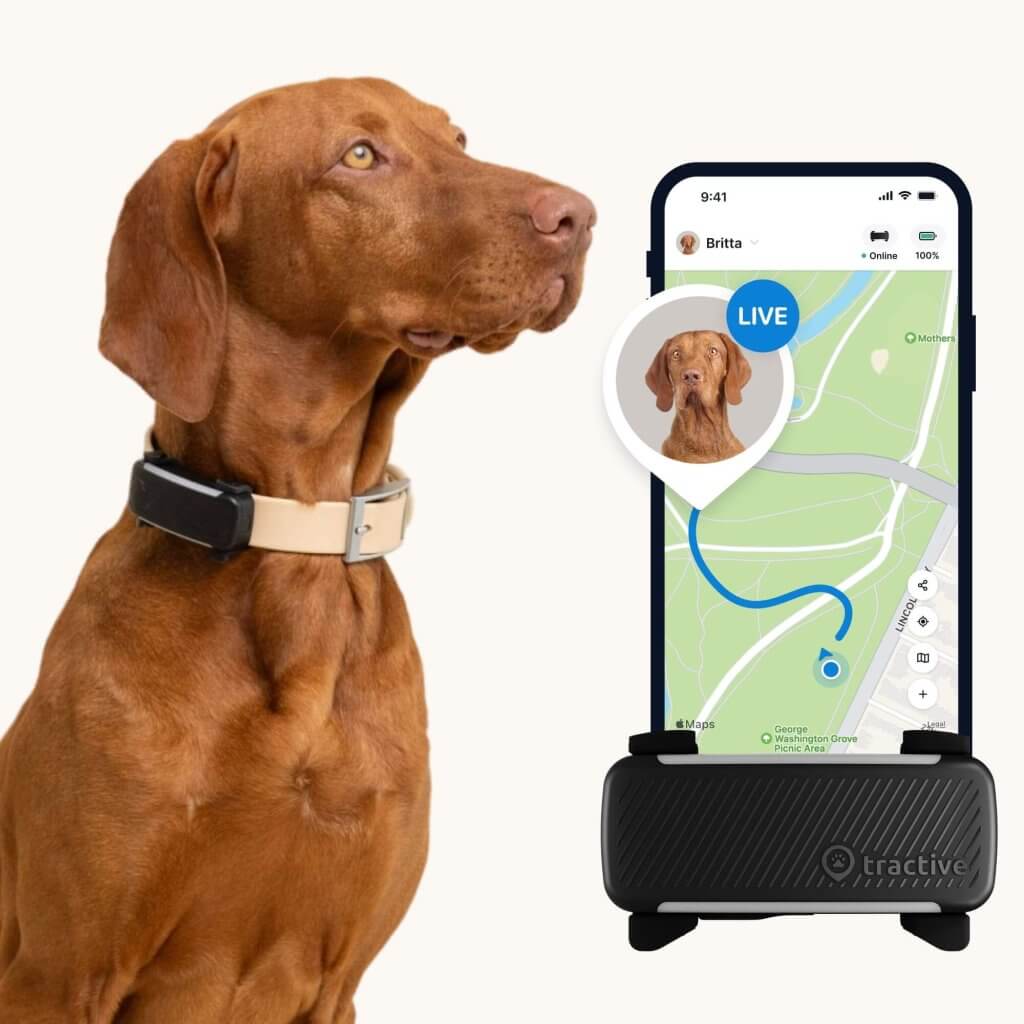
Follow your dog anywhere
Get real-time location information, wherever they go. And find out when they try to make an escape, or just when they go somewhere they shouldn’t, with Virtual Fences.
How to start geocaching with your dog
First, download a geocaching app like Geocaching® or Cachly. These apps provide access to a massive database of caches all over the world, and they’re beginner-friendly. Create a free account to start logging your finds, earning badges, and keeping track of your adventures together.
Next, pick a cache that’s dog-friendly. Look for geocaches located in parks, trails, or open nature areas. Apps often include notes and terrain ratings – aim for a rating of 1 to 2 for easy access with dogs. Some geocaches might be hidden in tricky spots (like under logs or near water). Check the description and recent logs to make sure it’s suitable for your pup.
Bring your dog’s gear, your phone, pen (for signing logs), hand sanitizer, gloves, and any small trade items if you’d like to swap treasures. We’ll cover some essential geocaching gear a little further below.
Finally, use the app’s map and GPS compass to navigate toward the cache. Once you’ve found the cache, log your name, and celebrate! Be sure to mark the cache as found in your app, and maybe even leave a paw-some note or photo from your furry teammate.
💡 Pro tip: Want to level up the fun? Create a geocaching journal to track all your finds and your dog’s favorite places. You can even rate the caches on your dog’s tail-wag scale!
Safety tips for geocaching with dogs
Your dog’s safety always comes first – especially when you’re off the beaten path. Make sure to stay on dog-safe trails and avoid routes with hazardous terrain, broken glass, sharp rocks, or plants that could be toxic to dogs (like poison ivy or foxtails). Also:
Watch out for the heat
Geocaching is most popular in spring and summer – but that also means dealing with rising temperatures, which can be dangerous for your dog if you’re not careful. Try and aim for early morning or late evening walks to avoid the midday sun. Stick to shaded trails, like forest paths or areas with natural cover are cooler and more comfortable for your pup.
Stop often in shaded areas, especially if your dog starts panting more heavily than usual. You could also pack a damp towel or cooling vest to help regulate your dog’s body temperature. Wet their ears and paws to help them cool off.
We’d also recommend you always carry fresh water and a collapsible bowl. Let your dog drink frequently, especially on hot or long hikes. If you have a light-colored dog, apply dog-safe sunscreen to vulnerable areas like the nose and ears if you’re out in strong sun.
Finally, watch for symptoms of overheating like excessive panting, glazed eyes, drooling, weakness, vomiting, or collapse. If you spot any of these, get your dog to a cool place immediately and contact a vet.
Check your dog’s paws regularly
Your dog’s paws take the brunt of the work during any outdoor adventure – so regular checks are a must. Trails can be rough, uneven, or strewn with hidden hazards. Asphalt and rocky surfaces can also heat up quickly and burn paw pads, especially in summer. Always check the ground temperature with your hand before heading out.
While out geocaching, take a few moments every now and then to inspect your dog’s paws. Look for:
- Cuts or abrasions
- Cracks or dryness in the paw pads
- Splinters or thorns stuck between toes
- Ice or snow buildup during winter walks
Once you’re back home, give their paws a thorough rinse – especially if you’ve walked through dirt, salt, or muddy terrain. Use a soft cloth or paw wipes to clean in between the toes, and gently pat them dry.
For added protection, consider applying a dog-safe paw balm before and after your outing. If you’re venturing into rocky or particularly rugged terrain, lightweight dog boots can help prevent injury and improve traction.
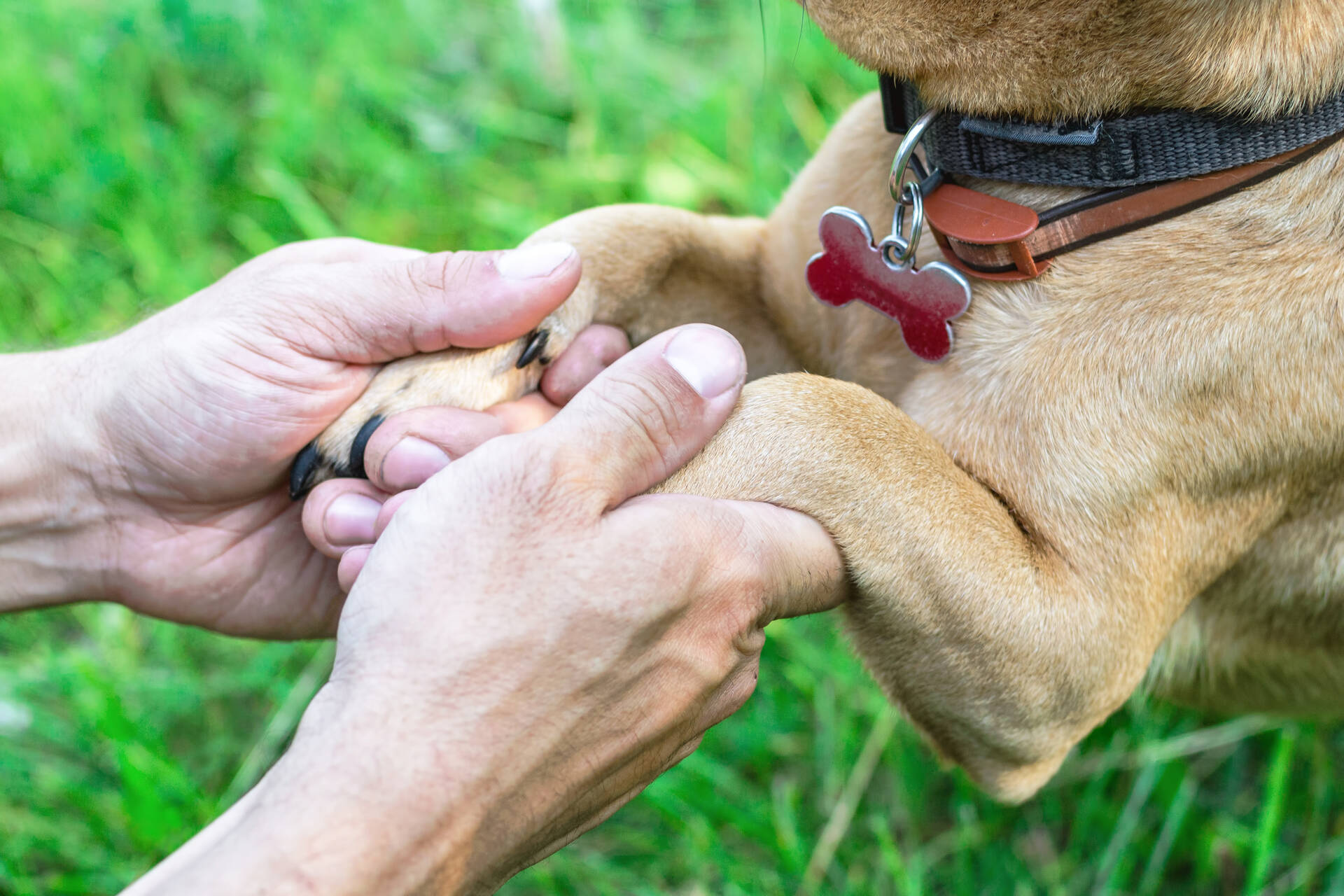
Beware of wildlife
Geocaching often takes you off the beaten path and into natural spaces where wildlife lives. While this can make for a beautiful and enriching experience, it also means you should:
- Keep your dog leashed at all times
Curious pups may try to chase or approach animals like deer, rabbits, or even snakes. Always keep your dog leashed or on a long lead in unfamiliar or wildlife-dense areas. If your dog has a high prey drive, consider using a front-clip harness or a short leash for better control. - Watch for warning signs
If your dog suddenly freezes, sniffs intensely, or fixates on something ahead, they may have spotted wildlife. Distract them with a treat or toy before they get too close. - Be alert for snakes or ticks
In warmer climates or during summer, be cautious around tall grass, rocks, and logs. These can be common hiding spots for snakes. Ticks also thrive in these environments, so always check your pup after your adventure. Make sure your dog has their flea and tick preventative before heading outdoors. - Respect the wildlife laws
Make sure you check any local hunting season dates ahead of time. During these periods, both you and your dog should wear bright, high-visibility gear to avoid being mistaken for wildlife. Consider skipping heavily wooded areas or choosing designated dog-friendly parks during peak hunting times. If you’re geocaching with a dog in a national park or protected area, double-check the local rules regarding dogs and wildlife. Some areas may require leashes or restrict dogs altogether.
Dog-friendly gear for geocaching
A well-prepped adventure makes all the difference. Here’s what to bring along:
- Comfortable harness and sturdy leash
A well-fitted harness gives you better control and is safer for your dog’s neck, especially if they get excited during the hunt. - A basic first-aid kit
Include antiseptic wipes, tweezers, gauze, and any personal meds your pup might need. - Poop bags
Always clean up after your dog, even in remote locations. It’s part of being a responsible geocacher. - Portable water bowl and water
A lightweight, foldable bowl makes it easy to keep your dog hydrated on the go. - Paw balm or dog boots
Great for rocky or hot surfaces to prevent paw damage. Paw balm can soothe and protect from cracking. - Towel or wipes
Handy for muddy paws, unexpected messes, or cooling down your dog on hot days. - Light-up collar or safety vest (optional)
Especially useful in low-light conditions or forested areas, so your dog stays visible. - Bug spray for dogs
Helps keep mosquitoes and biting insects away during your trek. - Spare leash or tie-out
Just in case you need to secure your dog for a rest break or unexpected moment.
💡Optional, but highly recommended: A dog GPS tracker. In case you’re geocaching with a dog that’s got a high prey-drive, tends to wander off by themselves, or tends to get easily distracted.
Where a dog GPS tracker can help in an emergency
Even the most obedient dogs can get curious and dash off after a squirrel or strange scent. And let’s face it -while geocaching, we’re often exploring new or unfamiliar areas where distractions are everywhere. That’s where the Tractive GPS & Health Tracker for dogs can be a potentially life-saving emergency measure.
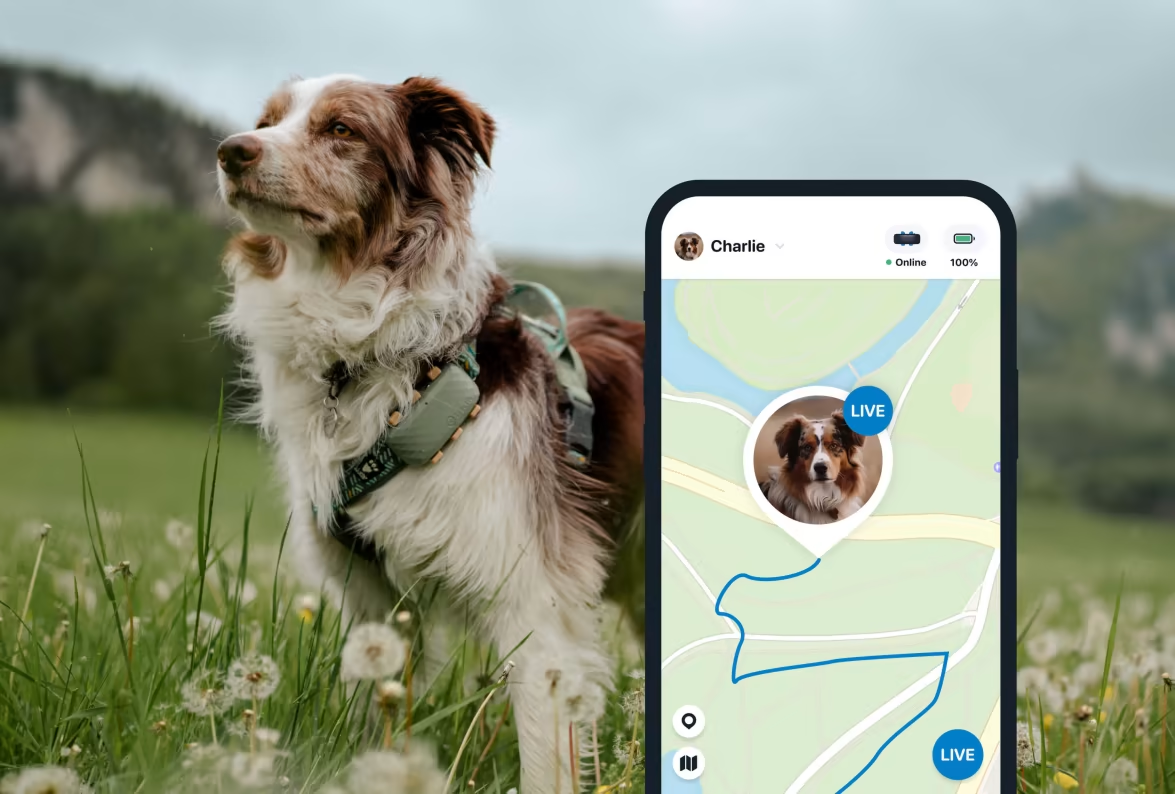
Just head to your Tractive mobile app and:
- Track your dog in real-time
With LIVE tracking, you can see your dog’s real-time location right from your phone. (Down to the smallest step they take.) Perfect if your pup takes an unexpected detour through the underbrush or disappears around a bend. - Set up a virtual “safe zone”
Like around your parked car or campsite. Now if your dog tries leaving this safe zone, you’ll get an instant escape alert warning you.
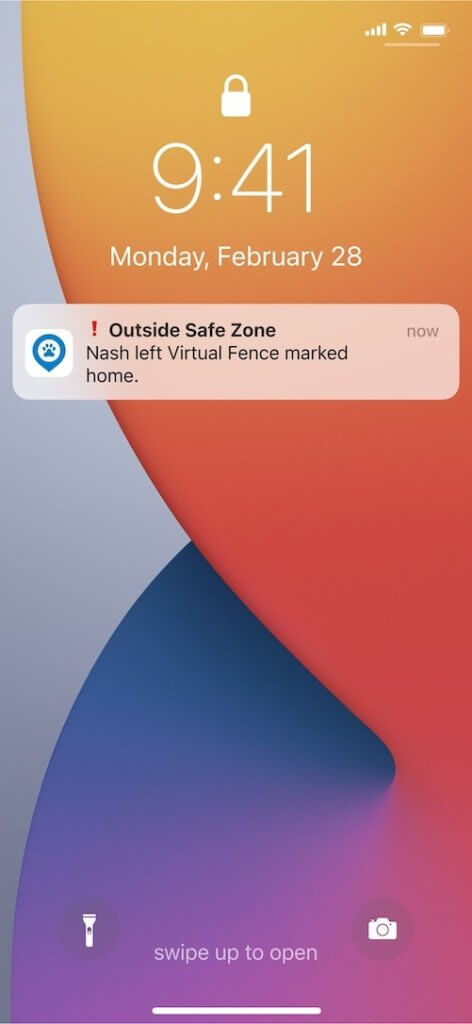

- Relive your favorite trails or cache finds
By checking your dog’s Heat Map and Location History. Trace your path and track where your dog has been. - Have an emergency measure that works even in remote areas
Unlike the Apple AirTag, Tractive GPS devices uses multiple network connections to help you keep track even when you’re deep in the woods. No need to depend on a network of iPhone or Android users near you. Plus, GPS means tracking your dog over an unlimited range.
Finally, with its lightweight, waterproof design, your trusty Tractive device was built with active dogs in mind. So it won’t weigh them down or get in the way, no matter how muddy the trail gets. So whether you’re exploring the forest, open fields, or unfamiliar parks, having a GPS tracker means you can relax and focus on the fun – knowing you’ll always be able to find your furry friend.
Ready for peace of mind on every trail?
Geocaching is more than a hobby – it’s a way to bring excitement, adventure, and enrichment into your dog’s everyday routine. With a little preparation, the right gear, and a curious spirit, you and your pup can turn your daily walks into epic treasure hunts.
Ready to give it a go? Start your first geocaching adventure this weekend – and don’t forget to bring your pup’s Tractive GPS Tracker so you can explore with confidence. Happy caching!
